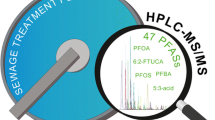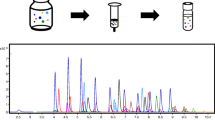Abstract
A new analytical method for the determination of 22 perfluoroalkylated (carboxylic and sulfonic) acids in water samples is presented. The method’s objective was to achieve the simultaneous quantification of compounds with different chain lengths (from C1 to C18). To this end, 500 mL of water were extracted with Oasis WAX solid-phase extraction cartridges and eluted with 3 mL of 5% ammonia in methanol. After evaporation to dryness, extracts were reconstituted in methanol:ultrapure water (1:1) and analyzed by mixed-mode liquid chromatography-tandem mass spectrometry (MMLC-MS/MS) using a weak anion exchange/reversed-phase column. The method provided good results, with limits of quantification lower than 1 ng/L in river water for most of compounds, except the two perfluorocarboxylic acids with the longest alkyl chain (>C14) and trifluoroacetic acid, for which a blank contamination problem was observed. The method proved good trueness and precision in both ultrapure and river water (R ≥ 81%, RSD ≤ 15%). After validation, the method was applied to the analysis of nine water samples where nine perfluoroalkylated acids were quantified. Seven of them were ultrashort- (C1-C4) and short-chain (C4-C8) perfluoroalkylated acids, pointing out the importance of developing methods capable to target such substances for further monitoring.



Similar content being viewed by others
References
Armitage JM, MacLeod M, Cousins IT. Comparative assessment of the global fate and transport pathways of long-chain perfluorocarboxylic acids (PFCAs) and perfluorocarboxylates (PFCs) emitted from direct sources. Environ Sci Technol. 2009;43(15):5830–6.
Lindstrom AB, Strynar MJ, Libelo EL. Polyfluorinated compounds: past, present, and future. Environ Sci Technol. 2011;45(19):7954–61.
Directive 2013/39/EU of the European Parliament and of the Council of 12 August 2013 amending Directives 2000/60/EC and 2008/105/EC as regards priority substances in the field of water policy (1).56.
Wang Z, DeWitt JC, Higgins CP, Cousins IT. A never-ending story of per- and polyfluoroalkyl substances (PFASs)? Environ Sci Technol. 2017;51(5):2508–18.
Brendel S, Fetter É, Staude C, Vierke L, Biegel-Engler A. Short-chain perfluoroalkyl acids: environmental concerns and a regulatory strategy under REACH. Environ Sci Eu. 2018;30(1):9.
Wang Z, Cousins IT, Scheringer M, Hungerbuehler K. Hazard assessment of fluorinated alternatives to long-chain perfluoroalkyl acids (PFAAs) and their precursors: Status quo, ongoing challenges and possible solutions. Environ Int. 2015;75:172–9.
Ateia M, Maroli A, Tharayil N, Karanfil T. The overlooked short- and ultrashort-chain poly- and perfluorinated substances: a review. Chemosphere. 2019;220:866–82.
Gremmel C, Frömel T, Knepper TP. HPLC–MS/MS methods for the determination of 52 perfluoroalkyl and polyfluoroalkyl substances in aqueous samples. Anal Bioanal Chem. 2017;409(6):1643–55.
Boone JS, Guan B, Vigo C, Boone T, Byrne C, Ferrario J. A method for the analysis of perfluorinated compounds in environmental and drinking waters and the determination of their lowest concentration minimal reporting levels. J Chromatogr A. 2014;1345:68–77.
Coggan TL, Anumol T, Pyke J, Shimeta J, Clarke BO. A single analytical method for the determination of 53 legacy and emerging per- and polyfluoroalkyl substances (PFAS) in aqueous matrices. Anal Bioanal Chem. 2019;411(16):3507–20.
Villaverde-de-Sáa E, Fernández-López M, Rodil R, Quintana JB, Racamonde I, Cela R. Solid-phase extraction of perfluoroalkylated compounds from sea water. J Sep Sci. 2015;38(11):1942–50.
So MK, Taniyasu S, Yamashita N, Giesy JP, Zheng J, Fang Z, et al. Perfluorinated compounds in coastal waters of Hong Kong, South China, and Korea. Environ Sci Technol. 2004;38(15):4056–63.
Taniyasu S, Kannan K, Yeung LWY, Kwok KY, Lam PKS, Yamashita N. Analysis of trifluoroacetic acid and other short-chain perfluorinated acids (C2–C4) in precipitation by liquid chromatography–tandem mass spectrometry: comparison to patterns of long-chain perfluorinated acids (C5–C18). Anal Chim Acta. 2008;619(2):221–30.
Shafique U, Schulze S, Slawik C, Kunz S, Paschke A, Schüürmann G. Gas chromatographic determination of perfluorocarboxylic acids in aqueous samples – a tutorial review. Anal Chim Acta. 2017;949:8–22.
Barzen-Hanson KA, Field JA. Discovery and implications of C2 and C3 perfluoroalkyl Sulfonates in aqueous film-forming foams and groundwater. Environ Sci Technol Letters. 2015;2(4):95–9.
Picó Y, Farré M, Barceló D. Quantitative profiling of perfluoroalkyl substances by ultrahigh-performance liquid chromatography and hybrid quadrupole time-of-flight mass spectrometry. Anal Bioanal Chem. 2015;407(15):4247–59.
Trojanowicz M, Koc M. Recent developments in methods for analysis of perfluorinated persistent pollutants. Microchim Acta. 2013;180(11):957–71.
Ruan T, Jiang G. Analytical methodology for identification of novel per- and polyfluoroalkyl substances in the environment.TRAC trends. Anal Chem. 2017;95:122–31.
Björnsdotter MK, Yeung LWY, Kärrman A, Jogsten IE. Ultra-short-chain perfluoroalkyl acids including trifluoromethane sulfonic acid in water connected to known and suspected point sources in Sweden. Environ Sci Technol. 2019;53(19):11093–101.
Zahn D, Frömel T, Knepper TP. Halogenated methanesulfonic acids: a new class of organic micropollutants in the water cycle. Water Res. 2016;101:292–9.
Yeung LWY, Stadey C, Mabury SA. Simultaneous analysis of perfluoroalkyl and polyfluoroalkyl substances including ultrashort-chain C2 and C3 compounds in rain and river water samples by ultra performance convergence chromatography. J Chromatogr A. 2017;1522:78–85.
Montes R, Rodil R, Cela R, Quintana JB. Determination of persistent and mobile organic contaminants (PMOCs) in water by mixed-mode liquid chromatography–tandem mass spectrometry. Anal Chem. 2019;91(8):5176–83.
Magnusson B, Örnemark U. Eurachem guide: the fitness for purpose of analytical methods – a laboratory guide to method validation and related topics. 2nd ed; 2014.
Montes R, Aguirre J, Vidal X, Rodil R, Cela R, Quintana JB. Screening for polar chemicals in water by trifunctional mixed-mode liquid chromatography–high resolution mass spectrometry. Environ Sci Technol. 2017;51(11):6250–9.
Janda J, Nödler K, Brauch H-J, Zwiener C, Lange FT. Robust trace analysis of polar (C2-C8) perfluorinated carboxylic acids by liquid chromatography-tandem mass spectrometry: method development and application to surface water, groundwater and drinking water. Environ Sci Pollut R. 2019;26(8):7326–36.
Yamashita N, Kannan K, Taniyasu S, Horii Y, Okazawa T, Petrick G, et al. Analysis of perfluorinated acids at parts-per-quadrillion levels in seawater using liquid chromatography-tandem mass spectrometry. Environ Sci Technol. 2004;38(21):5522–8.
Seitz W, Schulz W, Winzenbacher R. Advantage of liquid chromatography with high-resolution mass spectrometry for the detection of the small and polar molecules trifluoroacetic acid and sulfamic acid. J Sep Sci. 2018;41(24):4437–48.
Scheurer M, Nödler K, Freeling F, Janda J, Happel O, Riegel M, et al. Small, mobile, persistent: trifluoroacetate in the water cycle – overlooked sources, pathways, and consequences for drinking water supply. Water Res. 2017;126:460–71.
Zhao P, Xia X, Dong J, Xia N, Jiang X, Li Y, et al. Short- and long-chain perfluoroalkyl substances in the water, suspended particulate matter, and surface sediment of a turbid river. Sci Total Environ. 2016;568:57–65.
Acknowledgments
Special thanks go to Dr. Leo Yeung (former member of University of Toronto and currently at Örebro University) and Prof. Thomas Knepper and Dr. Daniel Zahn (Hochschule Fresenius) for providing us standards of perfluoroethane sulfonic acid, perfluoropropane sulfonic acid, and perfluoromethane sulfonic acid, respectively.
Funding
This work was supported by the Water Challenges for a Changing World Joint Program Initiative (Water JPI) Pilot Call (ref. WATERJPI2013 – PROMOTE), the Spanish Ministry of Economy and Competitiveness/Spanish Agencia Estatal de Investigación (refs. JPIW2013-117 and CTM2017-84763-C3-2-R), the Galician Council of Culture, Education and Universities (ref. ED431C2017/36) and FEDER/EDRF funding.
Author information
Authors and Affiliations
Corresponding authors
Ethics declarations
Conflict of interest
The authors declare that they have no conflict of interest.
Additional information
Published in the topical collection Persistent and Mobile Organic Compounds – An Environmental Challenge with guest editors Torsten C. Schmidt, Thomas P. Knepper, and Thorsten Reemtsma.
Publisher’s note
Springer Nature remains neutral with regard to jurisdictional claims in published maps and institutional affiliations.
Electronic supplementary material
ESM 1
(DOCX 126 kb)
Rights and permissions
About this article
Cite this article
Montes, R., Rodil, R., Placer, L. et al. Applicability of mixed-mode chromatography for the simultaneous analysis of C1-C18 perfluoroalkylated substances. Anal Bioanal Chem 412, 4849–4856 (2020). https://doi.org/10.1007/s00216-020-02434-w
Received:
Revised:
Accepted:
Published:
Issue Date:
DOI: https://doi.org/10.1007/s00216-020-02434-w




